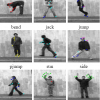Free Online Productivity Tools
i2Speak
i2Symbol
i2OCR
iTex2Img
iWeb2Print
iWeb2Shot
i2Type
iPdf2Split
iPdf2Merge
i2Bopomofo
i2Arabic
i2Style
i2Image
i2PDF
iLatex2Rtf
Sci2ools
144
Voted
CVPR
2009
IEEE
2009
IEEE
Max-Margin Hidden Conditional Random Fields for Human Action Recognition
We present a new method for classification with structured
latent variables. Our model is formulated using the
max-margin formalism in the discriminative learning literature.
We propose an efficient learning algorithm based on
the cutting plane method and decomposed dual optimization.
We apply our model to the problem of recognizing
human actions from video sequences, where we model a human
action as a global root template and a constellation
of several “parts”. We show that our model outperforms
another similar method that uses hidden conditional random
fields, and is comparable to other state-of-the-art approaches.
More importantly, our proposed work is quite
general and can potentially be applied in a wide variety of
vision problems that involve various complex, interdependent
latent structures.
Related Content
| Added | 09 May 2009 |
| Updated | 10 Dec 2009 |
| Type | Conference |
| Year | 2009 |
| Where | CVPR |
| Authors | Yang Wang 0003, Greg Mori |
Comments (0)

